As many of you have likely heard, a major leak from U.S. DOD headquarters has just occurred the day before yesterday. Initially, I wasn’t going to cover it because there was a strong chance it could be fake, and it’s not worth the effort of a full deep-dive for a document of questionable origin/validity.
However, now the Pentagram has confirmed the validity of the documents, as they’re now panickedly trying to scrub the internet of them. From NYTimes:
I won’t post the leaks directly here because apparently the accounts of people who are posting the direct screenshots on other sites have been ‘disappearing’. In particular, the account who first posted it on Twitter is now shown as nonexistent and presumably banned.
However, GrayZone, which has a history of breaking important leaks in the war has the information: LINK.
Also, here are some of the top Twitter breakdowns, here, here, and here.
**
As you know, we like to deep-dive into important leaks here, as I did for the big Delta Leaks which exposed U.S.’s C4ISR operations in Ukraine:
But before we dive in, a few contextualizing words. Firstly, despite the absolute authenticity of the documents at first glance, several things should be said as a precursor.
The initial copies which circulated all over Telegram were altered by [presumably] a Russian source who changed (photoshopped) the ‘Losses’ data, however original versions have now been found. (more on this later)
One obvious consideration is that this leak could be a mass deliberate maskirovka campaign by NATO/U.S. to fool Russia with seemingly authentic information on the offensive, which would intentionally steer Russian defenses in the wrong direction, etc.
So bear these considerations in mind. Yes, there is still a possibility that it is basically disinfo. Particularly because the timing of the leaked release so ‘conveniently’ falls right on the eve of the big AFU offensive.
Reuters claims the following:
Russia or pro-Russian elements are likely behind the leak of several classified US military documents posted on social media, Reuters reported.
However, there are certain extenuating circumstances that heavily point to the leaks being real. Which are namely that: there is apparently a much larger trove of leaked data that is floating around, in fact most of it is not even related to Russia / Ukraine and is in fact much more serious and ‘sensitive’ as per U.S. sources, as it pertains to highly secretive internal transmissions regarding China, the Middle East, and more. You can read about it on this new NYTimes article.
And secondly, there are a lot of pieces of info in the leaks which wouldn’t make logical sense in revealing if it was simple disinfo. For instance, revealing how many NATO/Western spy/intel assets are operating in Ukraine, etc. Such things only serve as evidence for Russia of U.S./West’s collusion an secret provocations/escalations, and serve as future legal proof of the West being the antagonist and initiator in the conflict, which gives Russia major legal and geopolitical advantages. That to me is too big of an oversight.
Also, the fact that much of it paints Russia in a favorable light, in terms of the pure numbers. If it was a deliberate leak, one would think they would sneak in some embarrassing or discrediting info about the Russian military, to paint it unfavorably, at least to some extent. Why let the world know how low Russia’s losses really are, for instance?
I’m partial to believing the flipside of the coin, which is that it was leaked on the eve of the offensive by disgruntled internal NATO employees wishing to sabotage the operation. Although it could be ‘part of the plan’, I don’t think the Biden admin would go so hard in trying to scrub the data off the internet if it were a real disinfo campaign.
And lastly, very little in the leak is actually ‘surprising’ or unknown information because much of it very accurately reflects all the projections that those of us who are on the ball have been making, and so it serves more as a confirmation of known facts. If it were true disinfo, I would expect that it would have some ‘surprising’ shocks that we didn’t anticipate, which would attempt to steer our analysis in some deflected direction, but it in fact confirms everything we’ve been seeing and reporting in many significant ways.
**
So, let’s begin with the breakdown. I will start with what I believe to be the most important, and ‘biggest’ stories of the leaks and work on down from there.
The biggest to me is the internal casualty count. As I said the first circulated document appeared to be doctored to show fewer Russian casualties and more Ukrainian ones. However the original document shows the internal losses as follows:
TOTAL ASSESSED LOSSES
Russia:
Assessed combat sustainability: MODERATE
72 fighter/bomber; 82 rotary-wing
6,004 ground vehicles
35.5k—43.5k KIA
Ukraine:
Assessed Combat Sustainability: MODERATE
60 fighter/bomber; 32 rotary-wing
11 strategic SAMs; 34 tactical SAMs
16k—17.5k KIA
Now, the first thing to note, as others have stated, is that the Ukrainian KIA appear to be taken straight from the ‘officially-released’ Ukrainian statistics, which points to several important possibilities. Which are that: 1.) the U.S. military has no real ability to track Ukrainian KIA and are simply taking them at their word 2.) This does in fact represent all the losses the U.S. can track, but the remainder are simply all the “MIA” whose bodies Ukraine doesn’t recover on purpose, or doesn’t officially list. 3.) This is an internal fib by the intel overseers handling these numbers. The purpose would be to lie to the U.S. leadership, so as to make Ukraine’s losses seem as low as possible so as to bolster morale, and keep leadership from abandoning Ukraine.
Big Serge
@witte_sergei
14h
@witte_sergei
The big takeaways (again, assuming the documents are authentic) are that the Ukrainian counteroffensive will be built around half strength brigades, and that NATO has no real insight into Ukrainian losses or frontline strength because Ukraine only gives them propaganda numbers.
Of course, we all know those KIA losses are not right. As others have mentioned, Mariupol alone had upwards of 15,000 ‘casualties’ in the form of 5,000 total POW’s taken and upwards of 10,000 KIA due to the fact that the Mariupol garrison had 15k total troops prior to being surrounded, and they never made it out of the city (barring a small trickle that were able to sneak out at the very beginning).
So we can ignore those. But the more interesting are the Russian losses. Firstly, as to the equipment numbers, they appear to be taken directly from Oryx’s list. I cross-checked them and they are almost identical with Oryx’s losses for aircraft and vehicles. What does that mean? Does the DOD simply take Oryx’s numbers as gospel? Certainly Oryx himself seems to think so as he’s made complaints in the past about how all the world’s militaries/intel services use his stats “without paying him”, so it appears that’s what they’re doing.
Or does the U.S. simply account for the same exact numbers, independently? It could be possible, it’s hard to say.
But the more important number is the KIA tally. They have Russian allied forces at 35-43k KIA. I had just written a comment to someone here last night that my casualty figures are almost exactly the same. I currently have Russian forces proper at around 15-18k KIA, and then another 15k are for the various paramilitary/irregular/volunteer/PMCs/etc.
And MediaZona, the most authoritative source of direct, strictly-confirmed casualty numbers currently has Russia at:
What is most interesting is how glaringly this internal U.S. figure contrasts with their ‘public’ statements that “over 200k” Russian troops have died. And in fact, up until a few months ago, for those who knew where to look, you could actually find the U.S.’s true casualty estimates, which were in line with these now secretly-revealed ones.
Wikipedia for instance, under the Ukraine war page, in the casualties section, had U.S. military sources estimating 20-30k for Russian casualties a few months ago, but this was quickly mopped up and memory-holed to be replaced with the new fake “100-200k+” citations.
For instance, using the WayBackMachine to snatch a snapshot of the wikipedia page from months ago, you can see that before the situation for Ukraine got absolutely dire, where the casualty reports got politicized due to the ‘sensitivity’ of showing Ukraine in a negative light because of their near-collapsing situation, this is what U.S. estimates had for total ALLIED KIA:
But now you can’t find that as it has been wiped out and replaced with the cartoony “200k KIA” figures.
**
Let’s turn to the next most important nugget, the total force power/disposition of both sides inside the conflict. This is of particular interest to me because I have been a lone voice of accurately depicting the true force numbers in the field. Most other analysts who have not looked into it deeply continue repeating the mantra about 1 million Ukrainian troops vs. 500-700k Russian-Allied forces, etc. But since my very first inaugural article here:
—I have outlined that the true numbers employed by both sides is far less than most people have it.
In Ukraine’s case the motive is obvious, they have to puff up their numbers as a veneer of strength for their Western partners, so as not to demoralize them. And for Russia, the opposite effect—the West inordinately pumps up Russia’s numbers to more dramatically drive home the portrayal of ‘failure’, because the higher Russia’s numbers look, the more of a ‘failure’ it appears Russia is suffering in Ukraine, and the more their fake casualty figures look realistic. After all, how can you make 200k casualties look plausible when Russia has only used 100-150k troops total for the vast majority of the conflict so far?
So in that vein, here’s what the internal leak shows us for the force totals of both sides:
Ukraine: 34 Maneuver Brigades, 13 Fires (artillery) Units.
27 Territorial Defense Forces Brigades.
A brigade is up to 5,000 men, but we know the vast majority of Ukraine’s brigades operate at 50% or less strength. So nominally, 34 maneuver brigades can be at most 170,000 bayonets, or as little as 80k or less. But they are augmented by an additional 27 brigades of territorial forces, which are much lesser trained, more lightly-armed, non-assault forces. This could amount to a maximum of 135,000 additional troops, or somewhere in the 60-70k range if they’re 50% manned on average.
This gives us a total of ~300k ground forces at most, and maybe 150k at the least. My estimate from that very first article quoted above was that the AFU had likely around 200-220k total forces, with maybe 250-300k as an absolute high ceiling, but less plausible.
Now, it also lists 13 ‘Fires Units’, which it interestingly calls ‘units’ rather than BDE’s (brigades) as for the previous categories. The reasons for this is likely because Ukraine’s artillery ‘brigades’ can’t quite be called brigades due to the supreme lack of actual artillery pieces (which we’ll get to later). In regular mech/motor units, for instance, it doesn’t matter if you have a lack of armor of some type, the raw troop numbers still represent a given ‘bayonet strength’ because those troops will still be fighting on the frontline.
However, in artillery units, if you have the troops but not the actual artillery pieces, then it makes no sense to call you a full brigade because your troops don’t represent ‘bayonet’ numbers as they will never be actually fighting, since artillery troops are only in the rear. So, these ‘units’ presumably represent some type of artillery ‘regiment’ that’s much smaller than a brigade, likely amounting to a real battalion or two equivalent. So this could add another something like 10-20k troops to the total, give or take.
Now, for Russia. They list Russia in total battalions:
Potential Maximum Combat Power: 544 BNs
Committed to Conflict: 527 of 544 BNs (97%)
Regular MVR BNs (Maneuver Battalions): 218 committed
Reserve BNs: 41
Auxillary BNs: 258
Total: 527
Located Inside Ukraine: 474 of 527 BNs (80% of Committed)
Combat Effective: 94 (+1) Maneuver BNs
Reserve BNs: 29
Auxilliary BNs: 241
Total: 364
Deployed Combat Ineffective:
Regular Maneuver Battalions: 72
Reserve BNs: 11
Auxilliary BNs: 27
Total: 110
Now, let’s break this down. This is one of the sections being analyzed erroneously by other analysts on social media. They are freaking out over the fact that it appears to show Russia having 97% of its forces “committed” to battle, implying that Russia has no reserves left and is therefore doomed in the face of the coming Ukrainian offensive.
Here’s what they’re misunderstanding:
Firstly, the total number of Russian battalions is shown as 544. A battalion is upwards of 800 troops, though once again, almost everyone in the war operates at lower percentages. But at nominal numbers, 544 x 800 = ~435,000. Keep in mind, this number represents total allied forces, most likely. How do we know that? Because right beneath it they give the ‘total assessed losses’ and use the figures for what appears to be all Russian-Allied forces as well. Not to mention that on the maps, many of the positions they show are DPR/LPR positions as part of these groupings.
So, firstly, let’s talk about the 435,000 number. In my first article which I posted earlier, I gave total Russian troop counts used in the SMO for the Russian army only as less than 100k for the majority of it, increasing to maybe 125-150k at the most prior to mobilization, while everyone else had the numbers at 200-250k Russian troops. The mobilization added 300k, as we know. So 300k + the 100k+ I had, plus LPR/DPR/Wagner gives us something very close to the U.S.’s internal figures of 435,000, which to me once again confirms the accuracy of my earlier numbers.
LDPR and Wagner forces have far less troops than people think. Particularly after losses, LDPR combined may be as low as 20k or less troops, and Wagner, which Ukrainian propaganda likes to claim is over 50k troops is really 20-30k at the most or less.
So now to the controversial part people are misunderstanding. The doc says 527 of 544 Russian BNs (battalions) are ‘committed to conflict’, representing 97%.
However, you can clearly see right underneath that, it breaks down ‘committed’ forces into regular, reserves, auxilliaries, etc. And on top of that, out of the 527 ‘committed’, it further breaks them down into “427 out of 527 located inside Ukraine” which is “90% of committed”.
So the people who think “committed” means ‘in battle’—why would a portion of them be literally outside of Ukraine? And why would ‘committed’ forces be listed as having dozens of ‘auxilliary’ and even ‘reserve’ battalions? You can’t be a “reserve” and yet be “in battle” at the same time. Once you enter battle, you’re now a frontline troop.
So the “committed” does not mean “in battle”. Committed here is referring to forces which are simply assigned to the conflict in an overall sense. It has no meaning as to their status of actual ‘in combat’ or ‘out of combat’. It just means they are part of a unit that is under the official structure and hierarchy of a given army group that is part of the conflict, under the command of the supreme SMO commander, in contrast to certain units which are still in Russia and will never be in the conflict, i.e. brigades comprised of conscripts and those guarding Russian interior cities and strategic sites, etc.
The closest thing we have to figuring out units actually in battle is differentiating between the listed “Regular MVR BNs” (Maneuver Battalions) of which there are 218, 268 auxilliary, and the Reserve BNs of which are 41.
218 MVR BNs gives us a ceiling of ~175k true maneuver frontline ‘bayonet’ troops. 41 reserves is ~33k held back. The 268 BNs ‘auxilliary’, which represents 214,000 men and are likely referring to non-bayonet strength logistics forces.
That would mean Russian forces really only have 175k true bayonet-strength fighting forces.
And out of these total numbers 474 out of 527 of the battalions are actually in Ukraine. Which means that 53 BNs or ~42k troops are in Belarus, Crimea, or elsewhere.
However, the maneuver battalions does not necessarily mean they’re in combat, just because there is a separate ‘reserve battalion’ category. Reserve battalion could simply mean actual official reserve forces, like an official designation similar to territorial defense, etc. But this doesn’t preclude a large portion of the ‘maneuver battalions’ themselves being in the 2nd and 3rd echelon rear lines and not committed to the actual frontline combat.
This probably sounds confusing, but the general gist is that, given this information, you cannot actually deduce how many Russian troops are on the actual frontline and fighting, as the terminology used here, like ‘committed’, merely refers to the conflict as a whole. And so, I suspect—as I’ve outlined before—that Russia continues to have a large amount of mobilized troops “committed” to the conflict, but still ‘sitting out’, i.e. not on the frontline, but still waiting in the rear lines. They are simply not listed as official ‘reserves’ because they are not reserve or territorial forces, many of them might have official designations as ‘assault groups’, but they are simply not currently being utilized in battle.
And in fact, other parts of this leak do appear to corroborate this, because in sections where they give total frontline counts for various sectors, the numbers look very low, and would be impossible if all those troops were actually committed to battle.
For instance, one document shows the numbers of both sides in the Donetsk theater as follows: 10-20k total AFU forces, and 23,050 Russian forces.
The Bakhmut axis as: 15,250-30,500 AFU, and 29,000 total Russian/Wagner.
On another doc, it gives the entire Kremennaya line grouping as under 50k troops. So just between those three, that’s about a little over 100k troops for Russia for almost every front except for Kherson.
One possible way to differentiate it, is that the above numbers I gave came from a listing that gave all the hot zones but under the specific ‘combat effective’ brigades moniker. This leads me to suspect that perhaps ‘combat ineffective’ are basically the battalions which are kept in the rear. And from the total I gave earlier, Russia is listed as having 110+ combat ineffective battalions, which, added to 40+ reserve battalions would be 150+ total that may be in the rear, which could be over 100k troops.
As for ‘combat ineffective’, it generally means any unit which is below 70% constitution—whether that means it has not been fully built up yet, or it has already been in battle and was attrited by 20-30%. This doesn’t necessarily mean the unit still can’t be used at all, but that it would get the official designation of ‘combat ineffective’. But since the vast majority of AFU’s units are likely in this designation, it’s a relative point.
**
Onto the next document, which shows some other eye-opening things that likewise comport with things I’ve been reporting for a while now.
It shows the numbers for Ukraine’s GMLRS and 155mm Rounds usage, as follows:
GMLRS (Guided HIMARS Rockets)
Last 24 Hours Expended: 28
Total Expended: 9,612
Enroute: None
Next 24 Hrs: None
155mm Rounds
Last 24 Hours Expended: 1,104
Total Expended: 952,856
Enroute: None
Next 24 Hrs: 1,840 155mm HE (PDA32)
There’s one box that’s too blurry to see for both, but appears to say 7-day xxxxx, which I can only assume to be a 7-day average for daily usage. For GMLRS this is given as 14, and 155mm is given as 2,746.
So what does this mean?
Firstly, confirmation that they are shooting somewhere between 14-28 HIMARS missiles per day, which—since HIMARS launchers fire 6 missile salvos, this means they are shooting about 2-4 salvos per day. And since typically they’ll fire 2-3 HIMARs trucks at the same time, this is basically 1 daily salvo of a 3 truck group, per day on average.
This proves that HIMARs usage is very low and is only being done on one important pinpoint target per day (usually a hospital or civilian gathering in Donetsk).
Also, considering the fact that they ‘officially’ have 20+ or more HIMARs trucks, and given the fact that Russia claims to have destroyed many of them, plus repeatedly claims to destroy most HIMARs missile deliveries, this appears to vindicate Russian MOD’s reports. Because there is no way you’re getting healthy amounts of missile deliveries and have 20+ trucks, yet you’re only firing on average 3 trucks worth per day. This seems to indicate either they’re very low on actual platforms, and most of them have been destroyed or most of the missile deliveries are destroyed and they have immense missile hunger that only allows them to fire 20-30 per day, which the previous 7 day period average shows as 14.
You’ll recall that in many reports I often rib the AFU with how ‘irrelevant’ the HIMARs have been for this very fact, because they only fire off a salvo or two per day, and this leak appears to confirm all of our suspicions. By the way, the total of 9,612 missiles fired, averaged over 370 days of war—which is what this leak is dated as—gives us a total of 9612 / 370 = 26. So they’ve averaged 4 salvos of HIMARs per day, not exactly a ‘game changer’.
And now for 155mm shells, a much more actually significant category. The numbers here are not very promising for the AFU.
It shows the last 24 hour period as having fired a feeble 1,104 shells. The 7 day average shows 2,746 daily, which means they’re firing even way lower than they’re reporting. Remember, the complaint is that they now fire 5-6k daily while Russia was firing 50-60k but was reduced to 10-20k per day. However this shows they’re not even hitting 5-6k numbers.
The total 952,856 for the war, divided by 370 gives us 2,575 average. So they’re actually averaging barely over two and a half thousand per day.
I should however note that, when giving total fired “artillery” numbers, both sides are likely not just referring to 155/152mm but tube artillery as well. So this number represents their 155mm fires only, and there could be another few thousand per day in Grad rockets, etc. So, it’s possible they do fire 5-6k total after all.
But the other eye-opening number shows a measly 1,840 shells enroute to being delivered. Which goes to show the small bread crumbs they get. In the case of GMLRS it is 0.
But once again—in reality, none of these figures are anything we didn’t know. I only call them ‘eye-opening’ in the sense that they confirm how poorly the AFU is doing in terms of armament.
Of interest, on the same doc it also shows:
Patriot:
Enroute: None
Next 24 hrs: None
JDAM-ER:
Enroute: None
Next 24 hrs: None
Enroute:
5x MaxxPro, 4x HMMWVs
And some amount of Phoenix Ghost drones which is hard to make out, looks like 23+ to me.
The other thing of note on this doc is the US/NATO SOF (Special Operations Forces) in Ukraine is listed:
US: 14x personnel
UK: 50x personnel
France: 15x personnel
Latvia: 17x personnel
Netherlands: 1x personnel
Total: 97x personnel
Total U.S. personnel in Ukraine: 100
DoS (Department of State) in Ukraine: 71
DoD (Department of Defense) in Ukraine: 29 (includes DAO (Defense Attache Office), ODC (Office of Defense Cooperation), USSOF (United States Special Operations Forces), and MSAU (Marine Security Augmentation Unit?)
Not surprisingly the wily British have the theater crawling with their SAS.
The doc also confirms their airborne assets and routes, the various British RC-135’s, NATO MQ-9’s and RQ-4’s, but to be quite honest, this is mostly public info that’s already common knowledge, and which we’ve already known.
**
Now the two most significant pages. First is one covering the air defense situation in Ukraine, which includes a map of all significant Ukrainian AD units in the country. However, more notably is a list, not only of every single system type and the quantities therein, but also their remaining ammo counts.
To summarize it very succinctly, almost every AD type is very low in number, including Western NASAMs and Iris-T systems. The only two systems with significant numbers are S-300s and BUKs, of which Ukraine appears to still have roughly 28 S-300 units, and 57 BUK units. Also there are 67 much older OSAs, but apparently there’s very little ammo for them.
In fact, that is the chief alarming revelation: almost every single system is nearly out of missiles/ammo. At current consumption rates, many of them are due to run out by April/May at the latest. By May, Ukraine will be almost completely indefensible, according to this doc. This is extremely bad news for their offensive, and huge news for the expected Russian offensive after that. But more on that later.
As an example, it lists S-300’s with having a total of 470+ total missiles on hand, divided into 28 actual TELs, this averages to about 16 missiles per TEL. Since most S-300 TELs can fire 4 missiles, this means that each remaining S-300 unit has enough ammo for basically 4 resupplies. The current expenditure rate is shown as 180 missiles per month, which means all S-300’s will be out of ammo by early May, as per the document.
The BUK is set to run out by mid-April.
And though there are a lot of OSAs left, they appear to have very little ammo and are due to run out entirely by June.
The document outlines the plan to desperately resupply all these systems from neighboring allies/partners, but there is no telling how many Soviet vintage missiles still remain in stock in any nation.
The doc reveals that S-300 and BUKs comprise 89% of all Ukraine’s medium/high-range AD. And that U.S. and Allied systems such as Stingers, Avengers, Gepards, Crotales, etc., “do not have the same deterrent effect on the threat of Russian multi-role aircraft.”
Also, NASAM, Iris-T, etc., are said to be “in limited quantity…unable to match Russian volume and cannot be layered.”
The final alarming assessment finds that: “Ukraine can withstand 2-3 more wave strikes.”
Presumably this refers to the large Russian missile/drone strike waves.
**
Lastly, by far the most significant document, and which is generating the most hype, is the NATO ‘Combat Power Build’ for the AFU’s upcoming Spring Offensive. It shows the detailed breakdown of every single new brigade with exactly the composition of its units in terms of the newly gifted Western equipment, with projections for Ukraine’s big offensive.
Firstly, it states:
“12 Combat Credible Brigades can be generated for the Spring Counteroffensive. 3 of these internally from Ukraine, and 9 are US and Allied & Partner trained and equipped. Of these latter 9 number, 6 of them can be ready by March 31st, and the final 3 would be ready by April 30th.”
Let’s break this down. Firstly, Ukraine can only field a total of 12 credible brigades for the big offensive. At most this represents 60,000 troops, a far cry from the scary 120-150k numbers we’ve been seeing bandied around recently. This number, as some have noted, appears even less than the big Kherson counter-offensives of last year, which Russia easily repulsed.
The only difference, of course, is that these brigades will be armed with the latest NATO gear.
So let’s look at that next. The main page shows the 9 U.S./Allied trained/equipped brigades with their allotted equipment, and timelines for the deliveries of same, including training periods, etc.
Most of the brigades should training periods from January to the end of March at the latest. This confirms why it was a week or so ago we began hearing reports from Ukrainian officials that “Ukraine is now ready for the offensive”, but that only the weather is the final obstacle.
The 9 brigades and their equipment is as follows:
116th Brigade:
90 x BMP (Polish/Czech), already delivered.
13 x T-64 (Ukrainian), on hand.
17 x Unspecified tanks, TBD.
12 x AS-90 (British 155mm howitzer), April delivery. —these are 155mm howitzers equivalent to Krab, M109, PhZ2000 etc.
47th Brigade:
99 x M2 Bradley, delivery in late March.
28 x T-55S (Slovakia), on hand.
12 x M109 (American 155mm SPG), on hand.
12 x D-30 (old Soviet towed artillery), on hand.
33th Brigade:
90 x MaxxPro (American MRAPS), 20 on hand, the rest by late March.
14 x Leopard 2A6 (German), delivery estimated in April.
4 x Leopard 2A4 (Canadian), delivery April.
14 x Leopard 2A4 (Polish), delivery March.
12 x M119 (US light 105mm old howitzer), on hand.
21st Brigade:
20 x CVRT (old British Scorpion with 76mm gun), delivery in April.
30 x Senator (Canadian IMV, equivalent to Humvee, etc., only light machine guns), on hand.
20 x Bulldog, 21 x Husky (British light APC, akin to M113), x 10 M113’s, on hand.
30 x T-64 (Ukrainian), on hand.
10 x FH70 (old Italian towed 155mm howitzer from 1960’s), on hand.
32nd Brigade:
90 x MaxxPro (American MRAP), on hand.
10 x T-72 (Netherlands), delivery by April.
20 x Unspecified tanks (wishful thinking), TBD.
12 x D-30 (old Soviet howitzers), on hand.
37th Brigade:
30 x Mastiff/Husky (British MRAP w/ light weapons), delivery in April.
30 x Mastiff/Wolf (same thing), delivery expected.
30 x Senator (Canadian IMV, equivalent to Humvee), delivery TBD.
14 x AMX-10 (French wheeled “tank” with small 105mm gun), delivery in March.
16 x Unspecified tanks (wishful thinking), TBD.
12 x D-30 (Soviet howitzers again), delivery TBD.
118th Brigade:
90 x M113’s (American Vietnam era APC tin-can), on hand.
28 x T-72 (Polish), by April.
6 x M109 (American 155mm SPG artillery), delivery in March.
8 x FH70 (old Italian towed howitzer), expected in April.
xxxx - Something unreadable but appears possibly more Senator IMV’s.
117th Brigade:
28 x Viking (Netherlands small APC), on hand.
10/20 x XA185 (Finnish APC equivalent to BTR-82a, etc.), estimated by April.
10 x Senators (Canadian Hummer), delivery TBD.
31 x PT-91 (upgraded Polish T-72’s), delivery in April.
12 x D-30 (Soviet artillery), on hand.
xxxx - Something illegible.
82nd Brigade:
90 x Strykers (American IFV), expected March.
40 x Marders (German IFV), expected April.
14 x Challenger-2 (British MBT), expected April.
24 x M119 (U.S. light towed howitzer 105mm), on hand.
So, these are the big bad Western brigades meant to be the crushing vanguard of the offensive to end all offensives? As noted earlier, there are 3 additional Ukrainian-sourced brigades; presumably those will have BMP-1’s and 2’s, T-64’s, any remaining T-72’s, and any remaining Gvozdika, D-30, M777 artillery, etc.
The first thing to note is the structure of each brigade is typically sticking to a single light tank battalion attached to each, usually comprised of about ~30 tanks. Then, most of them include around 90-100 IFV/APC/IMV like MRAPS or BMP equivalents distributed presumably in about 2-3 mechanized battalions.
Then there’s typically one attachment of 12-20 artillery units of some kind to each brigade, whether it’s ancient towed guns or self-propelled units.
The last listed brigade, the 82nd, is supposed to be an elite air assault brigade, so they were armed with the best stuff, the Strykers, German Marders, and UK Challengers. However, in the same document it states that the ‘Challenger ammo is limited’, which is not very promising.
The total strength of all 9 brigades taken from @snekotron’s post:
The nominal strength of the 9 brigades built up for this offensive is stated as 253 tanks, 381 IFVs, 480 APCs, and 147 artillery. However, much of this armor is listed "TBD" as in not yet arrived or repaired maybe.
As @snekotron further states:
By the end of April, they expect to have on hand 43 T-64, 38 T-72, 31 Twardy, 28 T-55S, 32 Leo 2A4, 14 Leo 2A6, 14 Challenger 2, 14 AMX-10. Another 53 listed TBD. First thing that jumps out is that Ukraine's prewar T-64s are almost all gone. /5
The vast majority of this, as can be seen, are old T-64’s, old T-72’s (i.e. not the highly upgraded T-72B3M’s that Russia enjoys), old T-55’s, 32 old Leopard 2A4’s which are much weaker than the upgraded 2A6’s, laughable French AMX-10 which aren’t even real tanks.
So, out of all that, the only worthy tanks are 14 Leopard 2A6’s and 14 Challenger-2’s, the rest is nothing for Russia to worry about, or that could stand a chance against Russian armor.
And as he hints below, these numbers appear to show that Ukraine’s previous tank armies have all been obliterated as there appears to be no sign of Ukraine’s previous massive T-72 numbers, for instance, in the form of the original Polish delivery of upwards of ~300+ tanks.
@snekotron
Ukraine also burned through the bulk of its armor deliveries last year, since they are now waiting on old new stock T-72s and PT-91 Twardys shipped from Poland. Many of the TBDs might be filled by Leo 1s, it's unclear. /6
One interesting take away from Dr. Snekotron’s conclusion above, is that the reason for U.S.’s paradoxically larger uncertainty vis a vis AFU troop numbers, which it sometimes gives in ranges, and doesn’t give as combat effective/ineffective as compared to Russian troop numbers which it often has more of a precise number for, could be due to the fact that AFU’s frontline forces are in such disarray, and the unit commanders lie and mislead—or outright don’t even know—about their own forces/losses/unit composition to such an extent, that even U.S. analysts are unable to get a true bead on many of their unit numbers.
In short, it paints a picture of the AFU frontline as a sort of Mad Max anything-goes Wild West. When it comes to the new unit compositions being created from the ground up for the coming offensive, however, the U.S. has the exact numbers.
Lack of visibility into Ukrainian formations is actually something that plagues this report, and it corroborates something that some have suspected for a while - that old units are just being left to bleed out while new formations are generated. /13
This explains why, for instance, on the casualty list they appear to have no clue, and just go with whatever number the AFU command gave them, which is the absurdly low 17k.
Dr. Snekotron agrees with this assessment:
It's like NATO builds these units, sets them loose on the front, and they disappear into a black box that is the Ukrainian General Staff and the SBU. They do not know what the combat capability of these units is so they must form new ones. /17
The combat losses, which have unfortunately been manipulated by Russian social media, are a good example of this black box effect. The original stated 35.5k-43.5k KIA on the Russian side and 16k-17.5k KIA on the Ukrainian side. /18
He goes on to mention a few other important last things I’d like to riff on:
The fact that Ukrainian brigades are now almost entirely dependent on foreign equipment and basically regiment-sized speaks to attrition over the course of a year of war. You don't send people out with a month of training (per this document) if one is avoiding losses. /21
The above is referencing one of the documents which lists 12 AFU brigades for the Bakhmut axis, but gives the troop count as 15-30k. A full brigade should be 5,000, which means 12 of them would be 60k troops. If the U.S. is estimating only 15-30k that means the AFU brigades are all operating at maximum 50% levels, and possibly even as low as 25% levels. This would constitute “brigades” with basically 1000-2000 troops at the most, in essence 1 or 2 battalions, rather than the standard 4+.
Also, one last point. The docs give the total GMLRS expenditure as 9,612 and 155mm expenditure as 952,856. Over the last 7 days an average of 14 and 2,746, respectively. This rate of fire is anemic, and the west is not going to be able to scale up soon. /26
Which also leads to a point I have been saying over the last few months, that the biggest problem to solve is the one of war industry. Russia just needs to fully staff its production - more ammo, more drones, more bombs. VKS bombing with glide bombs is uncounterable. /27
**
Some concluding thoughts to wrap it up:
My biggest takeaway from it all, is that the AFU’s supposed ‘coming offensive’ is truly a last hurrah, even more than we imagined. The reason is twofold:
1. Firstly, their numbers in general appear much lower in every regard. Not only is the manpower extremely low, but the Western equipment numbers are incredibly paltry compared to what was originally promised long ago.
2. And then, the second biggest story is how bad the shape of their AD missile stockpiles appear to be. With the high rate of consumption, they appear to be on the verge of complete defenselessness.
The story this paints is one of a last ditch hurrah. Firstly, it’s clear that the ‘main’ offensive cannot happen until early May at the earliest, because that’s when the last needed tank deliveries were scheduled for, according to these documents.
However, May is already the red-flag danger zone for A.D. consumption. So if they launch their massive offensive, and it fails throughout the month of May, by June they could be in a situation where their AD is so badly degraded that Russia can launch its own ‘Summer Offensive’ against a depleted, exhausted, now-armorless AFU which also can’t defend itself from the air.
And when you couple this with the fact that Russia is now reportedly using mass amounts of new guided aerial assets, (including Shoigu’s very foreboding visit to a bomb factory today, which showed some of Russia’s largest and scariest bombs being built, like the Fab-9000, a 9000kg monster), it all portends some very ill tidings for Ukraine.
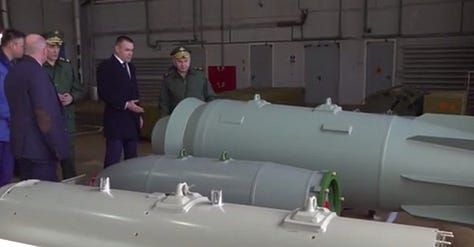
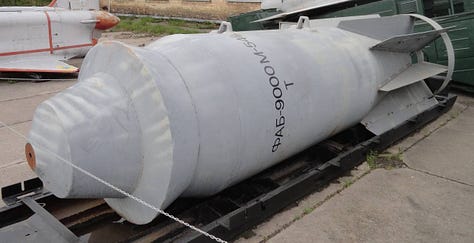
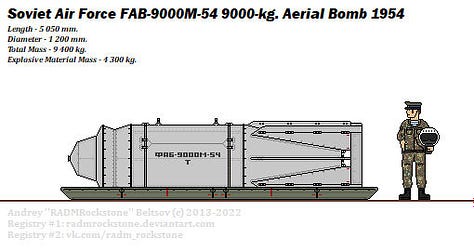
If these leaks aren’t deliberate maskirovka psyops, then by this Summer, the AFU could be in disastrously dire straits. A scenario where, with a depleted AD, they are now getting hammered with a fully activated Russian airforce dropping massive guided bombs with impunity, as the newly mobilized Russian forces stomp through the country, mopping up the remnants of their wrecked, understaffed brigades.
Of course, I still do give some consideration to the possibility that the leaks are a last ditch CIA psyop to lull us into a false sense of security. But think about the logic—how would such leaks truly ‘trick’ the Russian MOD itself, when Russia has its own advanced C4ISR, satellite recon, etc., capabilities to verify all this information? Everything inside the leaks are things Russia likely has long known already, so there’s very little chance that this would be an attempt to ‘trick Russia’ itself. The leaks are likely real. But, as I said, I’m not completely discounting the possibility.
And it’s not guaranteed that Ukraine is due to collapse. For instance, even the dire AD situation is not written in stone. In the documents themselves, there is a clear ‘course of action’ section which delineates the steps needed to be taken to keep their AD going. However, as mentioned before, the steps merely amount to begging nearby neighbors for more ammo, but there is no guarantee that they have much more to spare of these Soviet vintage missiles that are likely only produced in Russia.
So on one hand it’s not a definitive foretold collapse, but on the other, the outlook for the AFU doesn’t look good at all.
And lastly, the fact that only “12 combat credible” brigades can be generated for the offensive, as per the docs: though this represents 60k troops, and to some extent that sounds like a lot of forces. But on the other hand, we must remember that in order to make an effective breakthrough, the AFU had intended (at least by all known rationales) to attack on multiple disparate fronts.
For instance, there was to be a large Kherson/Dnieper landing group, a large group feinting towards Berdiansk/Mariupol by way of Volnovakha, a main thrust down towards Melitopol, etc. So, imagine splitting these 60k troops up into various directions of this sort; the outcome ends up being small groupings of 10-20k troops each attacking any given front. And that does not appear very worrying.
Of course, it’s always possible they could pull various other groups from different fronts, like Kremennaya, Bakhmut, etc., and add more brigades to these 12, but that would put the other fronts at risk of being overrun.
So, we’ll see. For now it appears there’s still time left, as—if these leaks are real—it shows a major offensive cannot come before May, at least not at the Southern Front. They are likely still planning a local Bakhmut counter-offensive with the reserves accumulated there.
If you enjoyed the read, I would greatly appreciate if you subscribed to a monthly/yearly pledge to support my work, so that I may continue providing you with detailed, incisive reports like this one.
Alternatively, you can tip here: Tip Jar





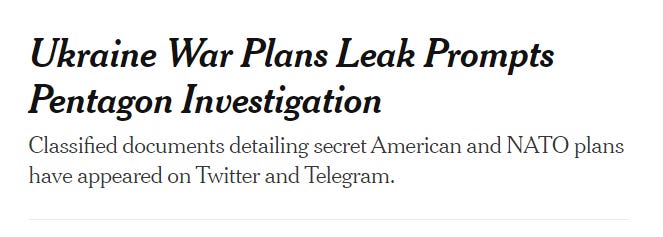




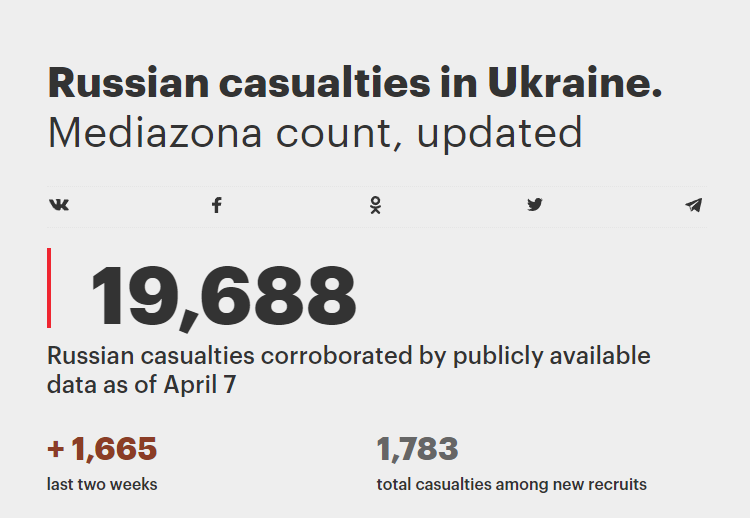

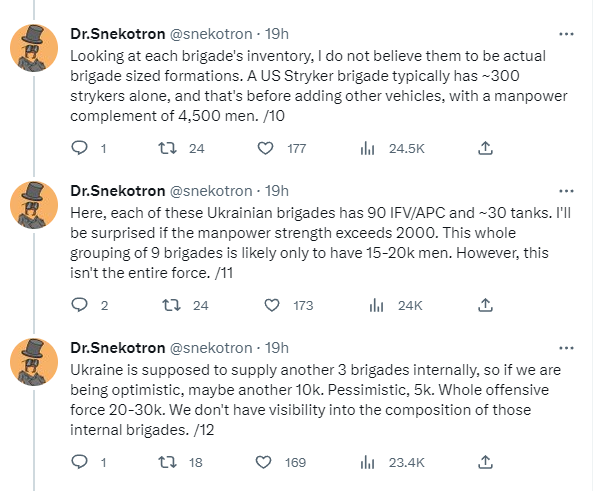
Thanks for the post but I put ZERO credance on this "leak". It was released to to the public for a reason and is likely a regurgitation of disinfo info Ukraine provided to NATO. Part of fog of war meant to distract and confuse. Meanwhile, Wagner has taken about 90% of Bahkmut now.
It's clearly a psy ops to mindscrew the Russians into being complacent about this coming offensive. The Nazis can't hide it so the US engaged in a massive disinformation campaign. They are the global experts in bullshitting.
Make no mistakes the Nazi offense will come before end of April. Too much maskarov spread even to normally pro Russian bloggers to proclaim that the Nazis are in no shape to launch any offensive.
Everything actually points to the coming offensive in evidences that really matters.
Take the total number of Nazis that are trained in US, Canada, UK, Europe and the numbers will reach 100k.
Look at Russian MOD daily reports and you'll see no tanks killed, no real AFV killed. Just mobile and static artillery and pickup trucks.
The real stuff is pulled back and gathered for the big push.
The west have always supplied more tanks, artillery, planes than they declared publicly.
So expect at least 600-800 tanks, more than 2k assorted AFVs, and minimum of 500 artillery/rocket.
It's the Nazis last shot as the west has run out of money and ammo to give them. Time is not on their side abd Satan is demanding souls.
I really hope Russia is prepared for this Do or Die
My guess is broad front attacks initially to mask true objective, and later to keep the Russians pinned to the whole front to prevent them from reinforcing the real objective once that's clear.
The nuclear plant is a secondary and much easier objective. Lots of PR and Russia is not going to risk irridiating their soldiers to die defending it. Expect the Nazis to throw 30k at it and Russia to withdraw. That's why the west flooded the Nazis with river fording equipment. After the plant is taken the Nazis will leave 20k to consolidate defences and sent 10k to the real objective. By itself it's a huge PR victory at very low cost. Russia will not risk blowing up the NPP just to defend it. Look for a Russian pull back there.
The real objective? Which is Mariupol and a shot at Crimea. that's 70k and most of the armour and artillery. Spitting distance for Nazi artillery even if they stopped there.